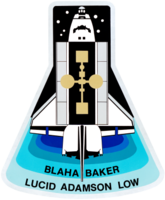STS-43
 | |
| Dane misji | |
| Indeks COSPAR | 1991-054A |
|---|---|
| Zaangażowani | |
| Oznaczenie kodowe | STS-43 |
| Pojazd | |
| Wahadłowiec | |
| Załoga | |
 | |
| Start | |
| Miejsce startu | Stany Zjednoczone, KSC, LC39-A |
| Początek misji | 2 sierpnia 1991 15:01:59.986 UTC |
| Orbita okołoziemska | |
| Apogeum | 306 km |
| Perygeum | 301 km |
| Okres orbitalny | 90,6 min |
| Inklinacja orbity | 28,5° |
| Lądowanie | |
| Miejsce lądowania | KSC, Pas startowy 15 |
| Lądowanie | 11 sierpnia 1991 12:23:25 UTC |
| Czas trwania misji | 8 dni, 21 godz, 21 min, 25 sek |
| Przebyta odległość | 5 955 216 km[1] |
| Liczba okrążeń Ziemi | 142[1] |
| Program lotów wahadłowców | |
STS-43 (ang. Space Transportation System) – dziewiąta misja wahadłowca kosmicznego Atlantis i czterdziesta druga programów lotów wahadłowców[2].
Załoga
- John Blaha (3)*, dowódca (CDR)
- Michael Baker (1), pilot (PLT)
- Shannon Lucid (3), specjalista misji 1 (MS1)
- James Adamson (2), specjalista misji 3 (MS3)
- George Low (2), specjalista misji 2 (MS2)
- *(liczba w nawiasie oznacza liczbę lotów odbytych przez każdego z astronautów)
Parametry misji
- źródło[1]
- Masa:
- startowa orbitera: 117 653 kg
- lądującego orbitera: 89 235 kg
- ładunku: 21 265 kg
- Perygeum: 301 km
- Apogeum: 306 km
- Inklinacja: 28,5°
- Okres orbitalny: 90,6 min
Cel misji
Umieszczenie na orbicie satelity telekomunikacyjnego TDRS-5[2].
Zobacz też
Przypisy
- ↑ a b c Mark Wade: STS-43 (ang.). W: Encyclopedia Astronautica [on-line]. [dostęp 2017-07-25].
- ↑ a b c Tomáš Přibyl: Dzień, w którym nie wróciła COLUMBIA. Bielsko-Biała: Wydawnictwo >DEBIT<, 2003, s. 166. ISBN 83-7167-224-1.
- ↑ Robert Godwin: Space Shuttle. Warszawa: Prószyński Media Sp. z o.o., 2011, s. 63, seria: Historia podboju Kosmosu. ISBN 978-83-7648-973-5.
Linki zewnętrzne
- podsumowanie misji STS-43 na stronie NASA (ang.)
- Mark Wade: STS-43 (ang.). W: Encyclopedia Astronautica [on-line]. [dostęp 2017-07-25].
- Spaceflight mission report: STS-43 (ang.). W: Spacefacts [on-line]. [dostęp 2017-07-25].
Media użyte na tej stronie
The flag of Navassa Island is simply the United States flag. It does not have a "local" flag or "unofficial" flag; it is an uninhabited island. The version with a profile view was based on Flags of the World and as a fictional design has no status warranting a place on any Wiki. It was made up by a random person with no connection to the island, it has never flown on the island, and it has never received any sort of recognition or validation by any authority. The person quoted on that page has no authority to bestow a flag, "unofficial" or otherwise, on the island.
The primary payload of the STS-43 mission, Tracking and Data Relay Satellite-E (TDRS-E) attached to an Inertial Upper Stage (IUS) was photographed at the moment of its release from the cargo bay of the Space Shuttle Orbiter Atlantis. The TDRS-E was boosted by the IUS into geosynchronous orbit and positioned to remain stationary 22,400 miles above the Pacific Ocean southwest of Hawaii. The TDRS system provides almost uninterrupted communications with Earth-orbiting Shuttles and satellites, and had replaced the intermittent coverage provided by globe-encircling ground tracking stations used during the early space program. The TDRS can transmit and receive data, and track a user spacecraft in a low Earth orbit. The IUS is an unmarned transportation system designed to ferry payloads from low Earth orbit to higher orbits that are unattainable by the Shuttle. The launch of STS-43 occurred on August 2, 1991.
STS-43 Mission Insignia
- Designed by the astronauts assigned to fly on the mission, the STS 43 patch portrays the evolution and continuity of the USA's space program by highlighting 30 years of American manned space flight experience -- from Mercury to the Space Shuttle. The emergence of the Shuttle Atlantis from the outlined configuration of the Mercury space capsule commemorates this special relationship. The energy and momentum of launch are conveyed by the gradations of blue which mark the Shuttle's ascent from Earth to space. Once in Earth orbit, Atlantis' cargo bay opens to reveal the Tracking and Data Relay Satellite (TDRS) which appears in gold emphasis against the white wings of Atlantis and the stark blackness of space. A primary mission objective, the Tracking and Data Relay Satellite System (TDRSS) will enable almost continuous communication from Earth to space for future Space Shuttle missions. The stars on the patch are arranged to suggest this mission's numerical designation, with four stars left of Atlantis and three to the right.
STS-43 Official crew portrait shows astronauts standing in front of a landed space shuttle orbiter at sunset. Crewmembers, wearing launch and entry suits (LESs) and holding launch and entry helmets (LEHs), are (left to right) Mission Specialist (MS) Shannon W. Lucid, MS James C. Adamson, Commander John E. Blaha, MS G. David Low, and Pilot Michael A. Baker. The portrait was created using a double exposure.




